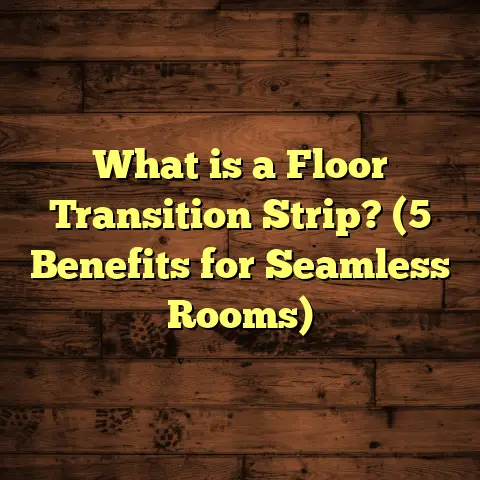What is Finished Floor Elevation? (5 Key Factors Explained)
The Rise of Precision: Why Finished Floor Elevation Is the Homebuilding Metric Everyone’s Talking About
Have you noticed how obsessed everyone’s getting with precision in homebuilding? I see it every day—homeowners want seamless transitions from room to room, no weird steps up or down, and definitely no water sneaking in when it rains. Even a few years ago, folks would shrug off little bumps between floors. Now? Clients bring laser levels to walk-throughs. This isn’t just about being picky—it’s about property value, safety, and long-term comfort.
I remember one open house in my area with a beautiful view and top-tier finishes, but the living room floor dipped by almost an inch in one corner. Buyers walked out. That’s how much things have changed. The new trend is about getting every detail right—and finished floor elevation (FFE) is the detail that quietly controls everything else.
Why Am I So Passionate About This?
I’ve worked on hundreds of flooring projects—custom homes, remodels, even historic buildings. I’ve seen what happens when FFE gets ignored: flooding nightmares, awkward stairs that trip people up, doors that won’t shut. And I’ve seen how smooth and hassle-free life is when it’s planned right from day one. Trust me—this is the stuff that separates a truly great build from an expensive headache.
What Is Finished Floor Elevation?
So let’s cut right to it. What is finished floor elevation? I get this question from homeowners all the time. Here’s my answer:
Finished floor elevation (FFE) is the final height of your floor’s top surface—right after all the materials are installed—measured from a fixed reference point like the ground or sea level. Think of it as the “zero mark” for your entire home’s interior space.
If you look at your blueprints or site plan, you’ll see little numbers next to “FFE” everywhere—front entry, garage, basement stairwell. Those numbers are not random. They tell everyone working on your home exactly how high to set things so that every part lines up perfectly—from door sills to window heights to where rainwater drains.
Where Is FFE Used?
- New construction: Architects set FFE before a single shovel hits the dirt.
- Home additions: Your new room needs to match the rest of your house—not just in looks but in height.
- Flood-prone areas: Codes require FFE to sit above flood danger zones.
- Commercial spaces: ADA compliance depends on correct floor heights for accessibility.
When you hear “FFE,” think of it as the master measurement that everything else revolves around.
Why Finished Floor Elevation Matters More Than Most People Realize
Let me ask you this: Have you ever visited a friend’s house and tripped over a step you didn’t see coming? Or noticed a door that scrapes the tile every time it opens? These annoyances almost always trace back to a problem with finished floor elevation.
But there’s more at stake than stubbed toes:
Water & Weather Protection
FEMA reports that raising a home’s FFE just one foot above the base flood elevation reduces flood risk by up to 80%. In New Orleans after Hurricane Katrina, new builds had to set FFE much higher than older homes. I saw entire neighborhoods rebuilt two feet above pre-Katrina levels—and insurance claims plummeted as a result.
Accessibility & Comfort
The Americans with Disabilities Act (ADA) sets firm rules: transitions between flooring types can’t be more than ½ inch high without a ramp. Miss this detail and you’re not just breaking rules—you’re making life harder for anyone with mobility challenges.
Smooth Design Flow
Ever see a kitchen remodel where tile sits half an inch higher than hardwood in the next room? It looks bad and creates a tripping hazard. Survey data from the National Association of Home Builders shows that homes with seamless transitions sell 12% faster on average.
Structural Integrity
If you build your floor too low or too high relative to the foundation or ground outside, you invite water problems—wood rot, mold growth, and cracked slabs. Fixing these later can cost thousands per room.
Resale Value
A recent study by Remodeling Magazine found that homes with well-planned floor elevations sold for 3–5% higher than similar homes with uneven floors or poor drainage.
Factor 1: Site Grading and Drainage—The Groundwork for FFE Success
Let’s start outside. Before you pour any concrete or lay any joists, you need to know exactly how your site slopes and where water will go during heavy rain.
The Science Behind It
Surveyors use laser levels or GPS equipment to map your lot’s contours. They’ll mark “high points” and “low spots” so everyone knows which way water naturally wants to flow.
If your FFE is too low—meaning your finished floor sits at or near ground level—you’re begging for water problems. Even if your foundation holds up, water can seep under siding or through basement walls. According to NAHB research, poor grading is responsible for over $2 billion in annual property damage.
My Experience
I had a client near Dallas who loved their low-slung ranch home. But after every thunderstorm, water pooled around their back door—and eventually crept inside. When we checked the plans, we realized their FFE was only six inches above surrounding grade. The fix? We re-graded the yard and added French drains, but it cost thousands more than doing it right from the start.
How Much Slope Is Enough?
The standard recommendation is a minimum slope of 6 inches drop over the first 10 feet away from your house (a 5% grade). This simple rule keeps rainwater moving away from your foundation.
Flood Zones
If you’re building in a known flood zone—like along rivers or coastal areas—local building codes may demand your FFE sit a full two feet or more above “base flood elevation.” FEMA’s maps are the go-to resource here.
Case Study: Gulf Coast Rebuild
After Hurricane Harvey in Houston (2017), new code required FFEs at least 24 inches above base flood elevation for new builds. The cost went up by about $9–$18 per square foot—but post-storm insurance claims dropped by nearly half according to local adjusters’ reports.
Factor 2: Foundation Types—Your Base Dictates Everything Above
Your foundation isn’t just what everything rests on—it determines what kind of FFE options you actually have.
Slab-on-Grade
This method is common in warmer climates. You pour concrete directly onto compacted soil or gravel. Your FFE is basically the top of this slab—so every decision about height needs to be made before pouring.
Pros:
- Lower cost (average $7–$14 per square foot installed)
- Fewer steps up/down into rooms
- Good for stable soil types
Cons:
- Harder to change later if you miscalculate
- Vulnerable to flooding unless raised above grade
Crawl Space Foundations
With crawl spaces, your structure sits on piers or perimeter walls—leaving space underneath for utilities. Your FFE is measured at the top of your subfloor above these supports.
Pros:
- Easier access for plumbing/electrical repairs
- Can raise home above minor flooding
- Allows better insulation options
Cons:
- More expensive ($13–$25 per square foot)
- Needs careful moisture control
Full Basements
In full basements, your main living level sits above below-grade storage or living space. Here, FFE refers to the main floor—the top of subfloor above basement walls.
Pros:
- Extra storage/living space
- Natural storm protection in some climates
Cons:
- Deep excavation cost ($18–$35 per square foot)
- Water intrusion risk if not perfectly waterproofed
Choosing Your Foundation Type Wisely
I had clients in rural Minnesota who wanted a basement but lived on clay-heavy soil with high water tables. We worked closely with engineers and set their FFE 36 inches above exterior grade—and installed sump pumps plus vapor barriers. Five years later? Not a single leak.
Industry Stat: Raised slab foundations boost insurance discounts by up to 20% in FEMA-mapped flood zones (source: Insurance Information Institute).
Factor 3: Flooring Material Choices—Why Every Millimeter Counts
Let’s zoom in on what actually makes up your finished floor—the visible surface plus all the layers beneath it.
Flooring Thickness by Type
| Flooring Type | Avg Thickness (inches) | Subfloor Needed? | Common Underlayment |
|---|---|---|---|
| Porcelain Tile | 0.5 – 0.75 | Yes | Cement board/thinset |
| Solid Hardwood | 0.75 | Yes | Rosin paper |
| Engineered Hardwood | 0.375 – 0.75 | Yes | Foam/vapor barrier |
| Laminate | 0.3125 – 0.5 | Yes | Foam pad |
| LVP/LVT | 0.16 – 0.31 | Optional | Cork/foam |
| Carpet + Pad | 0.375 – 0.625 | Yes | Foam pad |
I once had a client switch from carpet (with thick padding) to engineered hardwood mid-project. The new floor ended up almost half an inch lower, which meant every interior door had gaps underneath—and cold drafts blowing through in winter! We wound up installing custom thresholds throughout just to make things look finished again.
Layering Up: The Hidden Height Adders
You can’t forget about underlayments—foam pads under laminate/LVP, cement board under tile, plywood under hardwood—all these add up fast.
Example Build-Up Calculation for Tile Over Concrete:
- Concrete slab: baseline
- Crack isolation membrane: 1/8″
- Thinset mortar bed: 1/8″
- Tile: 3/8″ – 1/2″
Total Height Added: ~5/8″ – 3/4″
Why Futureproofing Matters
Are you planning on changing flooring types down the road? If so, aim for subfloor heights that let you swap between tile, wood, and carpet without huge elevation changes later on.
Case Study: Modern Open Concept Remodel
In a recent open-concept kitchen remodel, my clients wanted seamless transitions between tile (kitchen), LVP (living), and carpet (bedrooms). We pre-leveled all subfloors to a common height and chose underlayments that kept final FFEs within 1/8″ across all rooms. The result? No trip hazards and zero “step-up” thresholds anywhere.
Factor 4: Doorways, Stairs & Thresholds—Where FFE Mistakes Show Up Fast
This is where most homeowners first notice if something feels “off.” Even tiny differences in elevation can mess up transitions between rooms or make stairs unsafe.
Interior Doors
Standard practice is to leave about a 3/4″ gap under interior doors for airflow and operation over carpet/hard flooring. If your FFE ends up higher or lower than planned—say you switch materials last-minute—you might have to cut every door down or replace them entirely!
Exterior Doors & Water Protection
Exterior thresholds must always sit above final exterior grade—usually at least two inches higher—to keep out wind-driven rain or puddled water after storms.
Personal Story:
I once replaced a patio door that was flush with exterior pavers—a shortcut by the original builder—and every heavy rain sent water straight indoors. We raised the new threshold by two inches and sloped the patio away from house; problem solved.
Stairs & Riser Height
Building codes require every riser in a flight of stairs to be within 3/8″ of each other (2021 IRC). If your finished floor ends up higher or lower than planned because of last-minute flooring changes, you might wind up with an odd “short step” at top or bottom—a major tripping hazard.
OSHA Data
Uneven stair rises are one of the top contributors to household falls among adults over age 60.
Factor 5: Local Codes & Permitting—Don’t Get Caught Off Guard
Even if everything looks right on paper, local building codes could throw you a curveball.
Floodplain Regulations
Cities like Miami Beach require all new residential FFEs to be set at least +4 feet NAVD88 (a sea-level reference). In some parts of Louisiana post-Katrina, it’s +3 feet minimum. These rules can add $10k–$30k per build but save much more in avoided flood claims (Miami-Dade County data).
Permitting Hurdles
Most cities require permits for major grading changes or changes to finished floor height during renovations/additions. Inspectors will check that all elevations match approved plans before signing off on occupancy certificates.
Personal Anecdote:
A builder friend tried shaving $2k off costs by skipping permits for a porch addition—and was forced to tear out finished work after inspectors flagged non-compliant FFEs during final walkthrough!
My Step-by-Step Process for Getting FFE Right Every Time
- Order a full topographic survey: This gives me precise grade elevations across the entire lot.
- Consult local flood maps: FEMA and local city planning departments tell me if extra height is required.
- Stack up all material thicknesses: Subfloor + underlayment + finish material + any radiant heat mats.
- Coordinate with other trades: Plumbing rough-ins need exact heights based on subfloor; HVAC ducts must clear finished floors.
- Build mock-ups: For tricky transitions (like step-downs into garages), I do partial installs first.
- Submit plans for pre-inspection: City code officials review my proposed FFEs before I break ground.
- Double-check after every step: As each layer goes in—from joists to sheathing to underlayment—I re-check my measurements.
- Communicate constantly: If clients change flooring types mid-project (it happens!), I update everyone involved immediately so we can adapt before it’s too late.
Common Mistakes That Can Wreck Your Project—and How I Avoid Them
Forgetting Underlayment Thickness
It’s easy to overlook those “thin” foam pads under laminate or cork under LVP—but they add up over large spaces!
Ignoring Future Changes
Always plan for possible upgrades later (like going from carpet to hardwood). It’s easier to shim transitions now than rip out subfloors later!
Not Leveling Old Subfloors
Every shim or patch adds height somewhere—make sure these are balanced across whole rooms or you’ll end up fighting weird slopes forever.
Not Coordinating with Other Trades
Plumbers love setting drain heights before subfloors are finalized—but if your finished floor ends up taller than planned, suddenly shower pans don’t fit!
Data & Statistics: The Real Cost of Getting It Wrong
Let’s break down some real-world numbers:
| Problem | Avg Cost Per Sq Ft | Avg Total Cost | Source |
|---|---|---|---|
| Re-leveling slab post-build | $7 – $15 | $9k – $32k+ | HomeAdvisor |
| Flood repairs from low FFE | N/A | $8k – $25k+ | Insurance Information Institute |
| ADA non-compliance fixes | N/A | $5k – $50k+ | U.S. Dept of Justice settlement data |
| Custom door/threshold retrofits | $200 – $500 each | $2k – $8k+ | NAHB |
How Technology Is Revolutionizing Floor Elevation Planning
Laser levels have replaced string lines on most construction sites—they’re accurate within millimeters even over hundreds of feet! Drones equipped with LIDAR scanners map entire lots instantly after grading work.
Digital planning tools let architects model how different FFEs impact curb appeal, drainage flowlines—even sun exposure! On one complicated hillside project recently, we used Building Information Modeling (BIM) software to preview how changing FFE by just three inches would affect driveway slopes and garage access during winter snows!
Advanced Strategies for Challenging Homes
What if your lot isn’t flat? Or you want split-level designs? Here are some tricks I use:
Multi-Level Homes
Each “zone” needs its own FFE reference point—especially important when blending basements with raised main floors or garages set below living spaces.
Trick: Use steel shims under sill plates for fine tuning; custom stair landings bridge unusual elevation differences smoothly.
Retrofits & Remodels
Old houses rarely have perfectly level floors! I use self-leveling compounds over concrete or engineered plywood “sleepers” on wood subfloors before installing new finishes—keeps transitions safe and smooth even when original framing sags.
Green Building Approaches
Passive house design often raises floors above slab-on-grade using insulated concrete forms (ICFs), which creates airtightness and thermal breaks but requires extra planning for door thresholds and entry ramps.
Real-Life Stories—When Finished Floor Elevation Saved (or Sank) A Project
Story #1: The Flood-Proof Lakehouse
A couple near Lake Minnetonka wanted single-level living with wheelchair access—but worried about spring floods every year from snowmelt runoff. We set their FFE at +30 inches above lakeshore grade (12 inches higher than code minimum), built subtle exterior ramps instead of steps, and installed trench drains around patios. Five years later—with record rains—their neighbors had water inside while they stayed dry as bone!
Story #2: Open Concept Disaster Avoided
On one large open-plan remodel last year, we planned tile in kitchens/baths but LVP elsewhere—a difference of nearly half an inch in thickness! By mapping out all material layers before demo started, we adjusted subfloor heights in advance so everything met flush at transitions—no awkward step-ups or trip hazards for aging parents moving in soon after construction.
Story #3: Commercial Daycare Compliance Nightmare
A commercial daycare forgot about thick rubber matting required by law—which added almost an inch across playrooms! Suddenly doors jammed and bathroom partitions didn’t fit right until we reworked finishes throughout…at double original labor costs!
Frequently Asked Questions About Finished Floor Elevation
Q: How do I know what my home’s FFE should be? A: Ask your architect or builder for the site plan showing FFEs—they’ll base numbers on surveys plus local code requirements for drainage/flood protection.
Q: Can I change my FFE during construction? A: Sometimes—but it gets expensive fast! Moving plumbing/electrical rough-ins or repouring concrete can push project costs up by thousands per room if caught late.
Q: Will raising my FFE help with resale? A: Absolutely! A well-planned FFE boosts curb appeal and protects against future water damage—which realtors say increases value by an average of 3–7%, especially in flood-prone areas.
Q: What if my new flooring is thinner/thicker than my old? A: You might need transition strips at doorways—or sometimes extra underlayment beneath thinner floors so everything lines up correctly across rooms!
Expert Takeaways—How To Nail Your Finished Floor Elevation Every Time
Here are my golden rules:
- Start with survey data: Never guess—let science guide you!
- Plan drainage from day one: Keep water flowing away from your foundation.
- Stack every layer ahead of time: Don’t forget about underlayments or radiant heat mats!
- Work closely with every trade: Share elevation plans so everyone stays on the same page.
- Build mockups before committing: Test tricky transitions before laying thousands of square feet.
- Double-check local code requirements: Don’t let surprise inspections derail your project.
- Think about future changes: Plan today so tomorrow’s upgrades don’t become headaches.
- Communicate changes fast: If materials change mid-project alert everyone immediately!
- Use technology: Laser levels and digital models save time and prevent mistakes.
- Never cut corners on FFE—it always costs more later!
I hope this guide gives you confidence as you plan your next project—or helps you spot potential trouble before it starts! If you’re stuck on a tricky floor elevation decision or want advice tailored for your site/flooring combo just reach out; I’m always happy to help fellow homeowners avoid costly mistakes and enjoy floors that look great and work right for decades to come!





